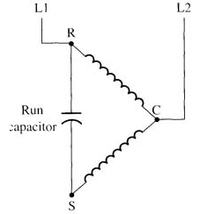samEEEf
Full Member level 2
First I want to make run an single phase induction motor. I have a small single phase induction motor (used in exhaust fan) with me right now. It has three terminals - 1. Red 2. Yellow and 3. Black
I know a capacitor is required in series with the auxiliary winding to make it self starting. I found in one document that Blue and Yellow wire are of the two terminals of main winding where black and red are from auxiliary winding. As my motor has only three terminals how I can identify the two winding? And how to connect power supply terminal and capacitor?
I know a capacitor is required in series with the auxiliary winding to make it self starting. I found in one document that Blue and Yellow wire are of the two terminals of main winding where black and red are from auxiliary winding. As my motor has only three terminals how I can identify the two winding? And how to connect power supply terminal and capacitor?

